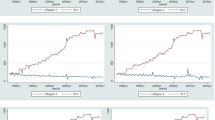Abstract
Supply cuts and pricing policies can be used to ration water. The appropriateness of a given policy depends on the losses in social welfare which it generates. We find some drawbacks with the only method in the previous literature which deals with the issue of measuring welfare losses under supply cuts. We propose an alternative method. We compare the welfare losses under supply cuts and a pricing policy during the drought period of 1992–1996 in Seville, Spain, using both methods, and find that the results vary widely from one method to the other.
Similar content being viewed by others
References
Arbués F, García-Valiñas MA, Martínez-Espinera R (2003) Estimation of residential water demand: a state-of-the-art review. J Socioecon 32:81–102
Billings RB, Day WM (1989) Demand management factors in residential water use: the Southern Arizona experience. J Am Water Works Assoc 81:58–64
Charney AH, Woodard GC (1984) A test of consumer demand response to water prices: reply. Land Econ 60:414–416
EMASESA (1997) Crónica de una Sequía: 1992-1995. EMASESA, Sevilla
Foster HSJ, Beattie BR (1979) Urban residential demand for water in the United States. Land Econ 55:43–58
Frederick KD (2002) Water resources and climate change. Edward Elgar Publishing, Cheltenham
Frederick KD, Major DC (1997) Climate change and water resources. Clim Change 37:7–23
Gibbons DC (1986) The economic value of water. Resources for the future, Washington, DC
Giupponi C, Shechter M (eds) (2003) Climate change in the mediterranean. Socioeconomic perspectives of impacts, vulnerability and adaptation. Edward Elgar Publishing, Cheltenham
Greene WH (2002) Econometric analysis. Prentice Hall, New Jersey
Hanke SH, Maré L (1982) Residential water demand: a pooled time-series cross-section study of Malmö, Sweden. Water Resour Bull 18:621–625
INE (2003) Cifras de población referidas al 1/1/03. Población de municipios por sexo. Instituto Nacional de Estadística, Madrid
La Caixa (2000) Anuario comercial español. Servicio de Estudios de La Caixa, Barcelona
Lee TR (1999) Water management in the 21st century: the allocation imperative. Edward Elgar Publishing, Cheltenham
Lund JR, Reed RU (1995) Drought water rationing and transferable rations. J Water Resour Plann Manage 121:429–437
Marshall A (1879) Water as an element of national wealth. In:Pigou A (ed) Memorials of Alfred Marshall. Kelley and Millman, New York, pp 134–141
Molina A (2001) EI servicio público de abastecimiento de agua en poblaciones EI contexto liberalizador. Tirant to Blanch, Valencia
Moncur J (1987) Urban water pricing and drought management. Water Resour Res 23:393–398
Opaluch J (1984) A test of consumer demand response to water prices: reply. Land Econ 60:417–421
Renwick ME, Archibald SO (1998) Demand side management policies for residential water use: who bears the conservation burden?. Land Econ 74:343–359
Renwick ME, Green R (2000) Do residential water demand side management policies measure up? An analysis of eight California water agencies. J Environ Econ Manage 40:37–55
Tirole J (1988) The theory of industrial organization. MIT, Cambridge
Varian H (1992) Microeconomic analysis. Norton & Company, New York
Winpenny J (1994) Managing water as an economic resource. Routledge, London
Woo C, Lo KWK (1993) Factor supply interruption, welfare loss and shortage management. Resour Energy Econ 15:339–352
Woo C (1994) Managing water supply shortage. Interruption vs. pricing. J Pub Econ 54:145–160
Author information
Authors and Affiliations
Corresponding author
Rights and permissions
About this article
Cite this article
Roibás, D., García-Valiñas, M.Á. & Wall, A. Measuring welfare losses from interruption and pricing as responses to water shortages: an application to the case of Seville. Environ Resource Econ 38, 231–243 (2007). https://doi.org/10.1007/s10640-006-9072-5
Received:
Accepted:
Published:
Issue Date:
DOI: https://doi.org/10.1007/s10640-006-9072-5




